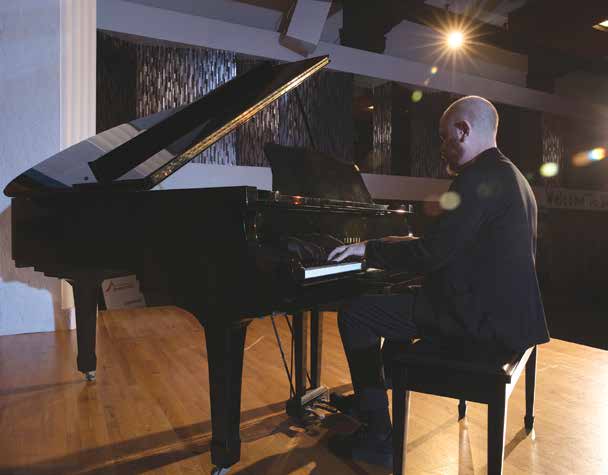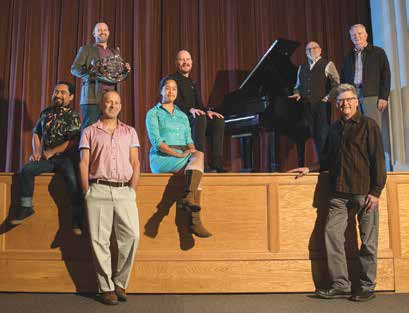In 1984, a talented, young musician died. He was an early and tragic loss of the AIDS pandemic that was only in its infancy. One of his prized possessions was a beautiful ebony grand piano. Normally, especially in those days, things left behind were sold or donated. Thanks to his friends and supporters, not this piano. Instead, it has taken a 35-year journey from San Francisco to San Diego and now back. The owner of that piano was the irrepressible musical entrepreneur Jon Reed Sims.
Last week, the National LGBTQ Center for the Arts received an amazing gift and an historic addition to the home of the San Francisco Gay Men’s Chorus (SFGMC): the Jon Reed Sims piano! Its arrival coincides with the Chorus’ 41st Anniversary. The gift was the personal piano of Sims, who founded the Chorus in 1978 just months after he founded the San Francisco Lesbian/Gay Freedom Band.
1977 through 1978 was a crazy time for our community. The City was absolutely bursting at the seams with gay, as Sims’ achievements indicate. Let’s take a look at what was happening around that time that helped create an atmosphere for so much exciting growth—and setbacks—in the LGBTQ community. I was not here. (I was straight then … I can hear your eye-rolls!) So, I asked some folks who were around during that time. These are only a few of the events they shared:
1977
• During her nationwide crusade against homosexuals, Anita Bryant received a pie in the face from gay rights activist Tom Higgins, prompting her to pray for Higgins’ salvation.
• The election of Harvey Milk galvanized the gay community and proved the political power of the movement.
• The first feature-length documentary on gay identity by gay and lesbian filmmakers, Word Is Out: Stories of Some of Our Lives, was presented at the Castro Theatre by members of the Mariposa Film Group.
1978
• Journalists and LGBTQ activists Roland Schembari and Bill Hartman founded the San Francisco Bay Times.
• Mayor George Moscone & Supervisor Milk helped to pass the broadest bill in the nation to ban discrimination in employment, housing, and public accommodation based on sexual orientation.
• Gilbert Baker created the Rainbow Flag so there was a now visible banner to help identify gay friends and allies.
• The Jim Jones and People’s Temple disaster brought national focus on San Francisco.
• John Briggs sponsored Proposition 6, also known as the Briggs Initiative, a failed statewide measure that attempted to remove all gay and lesbian school employees and their supporters from their jobs. It led to protests and organized opposition.
• June – The San Francisco Lesbian/Gay Freedom Band was founded.
• October – SFGMC was founded.
• November – The assassinations of Mayor Moscone and Supervisor Milk had the effect of creating a feeling that we were a community under siege, one with no alternative but to organize and fight back.

Lynden Bair, Artistic Coordinator, San Francisco Gay Men’s Chorus at the Jon Reed Sims Piano (Photo by Stuart Locklear, SGGMC)
Dreams and a Piano
Enter into this turbulent time a young Midwestern boy with huge dreams, lots of talent, and an entrepreneurial spirit that was unrivaled. He came with little but dreams and a piano!
Sims was born in 1947 in Smith Center, Kansas. He studied music at Wichita State University and earned a master’s degree in music at Indiana University after which he moved to San Francisco to be a music teacher. He taught high school band in Daly City, but ultimately devoted himself full-time to developing gay and lesbian musical groups throughout the Bay Area.
In 1978, he decided that the local Gay Freedom Day parade could use more music. Sims posted fliers around town, ultimately gathering together a few wind and percussion instrumentalists to form a marching band.
Long-time Freedom Band member Heidi Beeler shared this wonderful moment:
“In June 1978, a block of 70 musicians led by a skinny music teacher in jeans swung onto Market Street playing ‘California, Here I Come.’ The crowds along the length of the San Francisco Gay Pride Parade went wild as they passed by. They knew a radical act when they saw one. Jon Sims and the San Francisco Gay Freedom Day Marching Band & Twirling Corps (their original name) stepped out of the closet and into a tableau of Americana by marching down ‘Main Street’ in their community’s parade. What was supposed to be a summertime-only effort morphed into a permanent fixture. Band members would joke about Sims’ Kansas heritage, calling him Dorothy and likening their marching to following him down the yellow brick road.”
Joe Castrovinci was at the parade and recalled, “The one image of him I have is when he led the band down Market Street during that first Pride parade. To me, he looked like Robert Preston fresh out of The Music Man. He was not shy, loved being the focus of attention, and loved putting on a show—the bigger the better.”

(Left to Right) Gilbert Esqueda, Chorus member, SFGMC; Phillip Huff, Co-Director of Marketing, San Francisco Lesbian/Gay Freedom Band; Bruce Sinor, Acting President, Jon Sims endowment Fund; Andrea Nguyen, Board of Directors member and archivist, San Francisco Lesbian/Gay Freedom Band; Lynden Bair, Artistic Coordinator, SFGMC; Dr. Timothy Seelig, Artistic Director, SFGMC; Josef Aukee, Marketing Manager, SFGMC; Jerry Abrams, Treasurer, Jon Sims Endowment Fund (Photo by Stuart Locklear, SGGMC)
The band was an immediate success!
Sims decided that if there were gays who played flutes and trumpets, surely there were gays that sang. Once again, he created flyers; this time about the creation of a gay chorus. It was the fall of 1978. Like the Band, the Chorus was an immediate success, and both organizations are thriving 41 years later. The Band was the first musical nonprofit to proudly proclaim sexual orientation in its name. It was followed by the Chorus, which would be the first choral organization to “come out” and do the same. What a legacy was being built.
But wait.
Founding one band and one chorus was not enough for Sims. He also founded the San Francisco Lesbian and Gay Men’s Community Chorus (now known as the Lesbian/Gay Chorus of San Francisco), the Lambda Pro Musica orchestra, David Kelsey & Pure Trash, Varsity Drag, the FLAG Corps, the San Francisco Tap Troupe, and encouraged the formation of the Big Apple Corps GLBT band in New York and The Great American Yankee Freedom Band of Los Angeles.
‘An Alternative to the Baths and the Bars’
In a 1982 newspaper interview, Sims said that he was burned out and was suffering from exhaustion-related symptoms, which he compared with hepatitis. Two years later, in January 1984, he was diagnosed with a little-known disease called AIDS. He died six months later, on July 16.
One week after his death, more than 1,500 people attended a service at Grace Cathedral to remember the gifted musician. Attendees wore rainbow-colored armbands and entered under a rainbow archway of balloons. The service made the front page of The San Francisco Examiner the next day.
At the time, so little was known about AIDS that his obituary in the Examiner included a definition of the disease. AIDS had claimed the lives of 200 men in San Francisco, with Sims said to have been the 200th. Two thousand lives by then had been lost nationwide to AIDS. Sims’ death expanded awareness of an often-misunderstood disease that would go on to ravage San Francisco.
As one friend said of Sims in an obituary, he gave gays “an alternative to the baths and the bars.” Sims’ cultural impact is very much evident throughout San Francisco and the world.
Following the creation of the Band and the Chorus, similar groups began to spring up all over the nation and eventually the world. The bands soon formed the Lesbian and Gay Band Association (LGBA) and the choruses formed the Gay and Lesbian Association of Choruses (GALA Choruses).
Sims’ vision was limitless. Only a portion of it came to life, and yet that part has spanned the globe, changing the lives of millions of people. He knew that this would happen. That’s the way visionaries are. The loss of Sims and dreams would be the beginning of unfathomable deaths of the best and most creative among us.

Jon Sims, standing behind Bette Midler, was surrounded by SFLGFB members after their performance welcoming her to Walden Books. (1983). (Photo by Rink)
Now, About the Piano
Doug Litwin, Board Secretary of the Jon Sims Endowment Fund for the Performing Arts (JSEF) has helped us with its history. ( https://sites.google.com/site/jsef01/ )
When Sims passed away in 1984, his ebony Yamaha grand piano was left to good friends who were members of the Lesbian/Gay Freedom Band. In 1991, the piano was donated to the JSEF. For the next 14 years, it resided in the Noe Street home of the JSEF Treasurer. In 2005, the piano was moved to San Diego by the JSEF President, Loren McGlade.
On July 9 of this year, McGlade passed in San Francisco after a long illness. On July 22, the Board of the JSEF voted unanimously to offer the piano to the SFGMC. We are completely humbled by this gesture.
The C3 is the 6-foot grand version of Yamaha’s Conservatory Series. This is one of the most widely respected and recorded pianos in the industry. These are crafted by Yamaha in Kakegawa, Japan, and are made of the finest materials. Yamaha pianos are known for their sparkling sound and wide range of expression.
Litwin says, “It seems incredibly poetic that this historic instrument can add even more beautiful music to that which is already coming from that space. Hopefully, the piano and everything it represents will be incorporated into your Jon Reed Sims Legacy Society.”
The National LGBTQ Center for the Arts will be a home for all manner of music in the decades to come. Sims’ piano, which now sits on the stage of the 300-seat theater in the building, will be used by members of our community for all types of music. We can’t wait to see what it will accompany! Sims would be thrilled to see his piano helping to fulfill his own dreams of music-making for all.
Our first thank you is to the JSEF Board of Directors. It would have been easy to simply sell the piano upon Sims’ death. There are not many homes in San Francisco that can house such an instrument. But they did not do that.
As mentioned, there are literally hundreds of thousands, if not millions, of people who have benefited from the organizations that Sims founded, and the piano is a beautiful physical memento of a life that was such a gift to the world. The members of JSEF knew that and have treasured and cared for the piano for these decades. This is a remarkable labor of love on their part.
We at SFGMC pledge to care for the piano over the next decades. We’ll dust it, tune it, love it. Every time those keys are tickled, we will think of that bigger-than-life Kansas boy who found his Oz and made it a better place for all of us.
Thank you, Jon Reed Sims. Without you, our world would be much less fabulous. Your music lives on.
Dr. Tim Seelig is the Artistic Director of the San Francisco Gay Men’s Chorus.
Published on November 14, 2019
Recent Comments